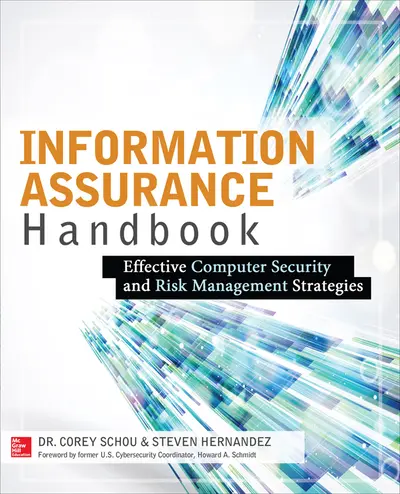My Account Details

ISBN10: 0071821651 | ISBN13: 9780071821650

Step 1 . Download Adobe Digital Editions to your PC or Mac desktop/laptop.
Step 2. Register and authorize your Adobe ID (optional). To access your eBook on multiple devices, first create an Adobe ID at account.adobe.com. Then, open Adobe Digital Editions, go to the Help menu, and select "Authorize Computer" to link your Adobe ID.
Step 3. Open Your eBook. Use Adobe Digital Editions to open the file. If the eBook doesn’t open, contact customer service for assistance.
Publisher's Note: Products purchased from Third Party sellers are not guaranteed by the publisher for quality, authenticity, or access to any online entitlements included with the product.
Best practices for protecting critical data and systems
Information Assurance Handbook: Effective Computer Security and Risk Management Strategies discusses the tools and techniques required to prevent, detect, contain, correct, and recover from security breaches and other information assurance failures. This practical resource explains how to integrate information assurance into your enterprise planning in a non-technical manner. It leads you through building an IT strategy and offers anorganizational approach to identifying, implementing, and controlling information assurance initiatives for small businesses and global enterprises alike.
Common threats and vulnerabilities are described and applicable controls based on risk profiles are provided. Practical information assurance application examples are presented for select industries, including healthcare, retail, and industrial control systems. Chapter-endingcritical thinking exercises reinforce the material covered. An extensive list of scholarly works and international government standards is also provided in this detailed guide.
Comprehensive coverage includes:
- Basic information assurance principles and concepts
- Information assurance management system
- Current practices, regulations, and plans
- Impact of organizational structure
- Asset management
- Risk management and mitigation
- Human resource assurance
- Advantages of certification, accreditation, and assurance
- Information assurance in system development and acquisition
- Physical and environmental security controls
- Information assurance awareness, training, and education
- Access control
- Information security monitoring tools and methods
- Information assurance measurements and metrics
- Incident handling and computer forensics
- Business continuity management
- Backup and restoration
- Cloud computing and outsourcing strategies
- Information assurance big data concerns
1:The Need for Information Security
2:Concepts in Informaiton Security
3:Assets, Threats, Vulnerabilities, Risks, and Controls
4:Security Professionals and Organizations
5:Information Security management System
6:Implementing Information Security Strategy into Current Practices, Regulations, and Plans
Part IIInformation Security Planning Process
7:Approaches to Implementing Information Security
8:Organizational Structure for Mananging Information Security
9:Asset Management
10:Information Security Risk Management
11:Information Security Policy
12:Human Resouce Security
13:Certification, Accreditation, and Assurance
Part IIIInformation Security Prevention Process
14:Information Security in System Development
15:Physical and Environmental Security Controls
16:Information Security Awareness, Training, and Education
17:Preventive Tools and Techniques
18:Access Control
Part IVInformation Security Detection Process
19:Information Security Monitoring Tools and Methods
20:Information Security Measurements and Metrics
Part VInformation Security Recovery Process
21:Information Security Incident Handling
22:Computer Forensics
23:Business Continuity
24:Backup and Restoration
Appendices
Need support? We're here to help - Get real-world support and resources every step of the way.